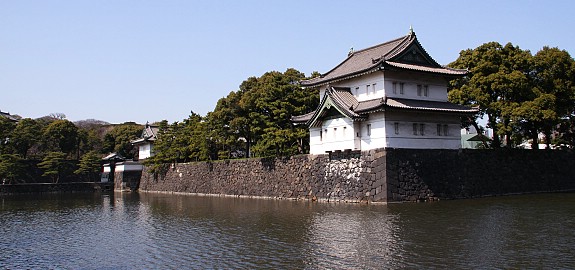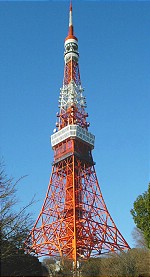Tokyo
About the City
Tokyo is one of Japan's 47 prefectures (ken), but is labeled as a metropolis (to). It consists of 23 city wards, 26 cities, 5 towns, and 8 villages. The 23 city wards are in the center of Tokyo and house around 8 million of the metropolis' 12 million citizens. Up until 1868, Tokyo was known as Edo instead. It was a small castle town and became Japan's political center in 1603.
What to See
Top Nine
1. Imperial Palace

The current Imperial Palace is called Kokyo. It is located at the former site of Edo Castle. There is a large park area surrounded by moats and huge stone walls. It's located in the center of Tokyo and is only a short walk from Tokyo Station. It is also the home of Japan's current Imperial Family. The palace was built in 1888 when the country's capital was moved from Kyoto to Tokyo. It was destroyed during World War Two and then rebuilt exactly the same.
2. Tokyo Tower

Tokyo Tower stands at 333 meters, 13 meters taller than the Eiffel Tower in Paris that it was modeled after. Completed in the year 1958, it is symbol of Japan's rebirth as a major economic power. It is also a television and radio broadcast antenna, and a tourist attraction as it is the world's tallest self-supporting steel tower. Tourists can climb to both the main observatory at 150 meters and the special observatory at 250 meters to see the city from a bird's eye view. During good weather conditions, Fuji-yama can be seen in the distance. On the ground floors an aquarium, wax museum, and several more attractions can be found. Tokyo Tower is located next to Zoioji Temple.
3. Odaiba Island
Odaiba means "great fort," and refers to some of the man-made islands in the Bay of Tokyo, which were contructed in the end of the Edo Period to protect the city from sea attacks. During the 1980s the islands began to be developed into a futuristic business district. Unfortunately the development was slowed down after the "bubble economy" burst in the 1990s. The island now serves as a tourist district and has many shopping and entertainment hotspots. The area is currently being further developed.
4. Sensoji (Asakusa Kannon)
5. Meiji-Jingu
6. Zojoji Temple
7. Tokyo International Forum
8. National Diet Building
9. Roppongi Hills and Mori
Museums
Edo Tokyo Museum
Nation Museum
Transportation Museum
Met Art Museum
Western Art Museum
Kanto Earthquake Museum
Fukagawa Edo Museum
National Science Museum
Met Photography Museum
Kite Museum
National Art Museum
Ghibli Museum
Amusement Parks
Tokyo Disney Sea
Fuji-Q Highland
Laqua
Yomiuiriland
Tokyo Disney Sea is Japan's Disney themepark. The park includes attractions such as Tower of Terror and the Legend of Mythica. It is divided up into seven "ports", each featuring a different theme of attractions. The ports are Lost River Delta, Port Discovery, Arabian Coast, Mermaid Lagoon, Mysterious Island, American Waterfront, and Mediterranean Harbor.
Lost River Delta is set in Mexico and contains the Indiana Jones Adventure: Temple of the Crystal Skull show along with Mystic Rhythms, Salsa! Salsa! Salsa!, and Musica Mexicana. Port Discovery holds StormRider, Aquatopia, and the DisneySea Electric Railway. Arabian Coast has Sinbad's Storybook Voyage, The Magic Lamp Theater, and Caravan Carousel. Mermaid Lagoon features Ariel's Playground, The Whirlpool, Scuttle's Scooters, and Flounder's Flying Fish Coaster. In Mysterious Earth you will find Journey to the Center of the Earth and 20,000 Leagues Under the Sea. American Waterfront is based off of the American Disney parks and contains many popular attractions found in those parks. Mediterranean Harbor is home to Fortress Explorations and the Venetian Gondolas. Each port also has many food and shopping opportunities.
Fuji-Q Highland, sometimes also spelled "Fujikyu", is one of Japan's major amusement parks. Featuring rollercoasters such FUJIYAMA and BIRDMEN, thrill rides like Labyrinth of Horrors and Panic Rock, go-karts, and Thomas Land, it is wildly popular among kids. With its many indoor attractions, the park is great even on rainy days. Many of the rides are also handicap accessible.
The Laqua park is located in Tokyo Dome City and is a combination of shopping mall, amusement park, and spa.
Other
Cherry Blossom Viewing (Hanami)
What to Eat
Bikkuri Sushi
Botan
Tonki
Sushi rolls by on conveyor belts and the customers pick and choose; perfect for the sushi novice -- individual sized portions allow for experimenting; items range in price (the color of the plate indicates the price of te selection) making this a great place for a small meal or inexpensive sushi pig-out.
This traditional restaurant serves only chicken nabe at a set price (approx. $65); the meal is prepared on a grill at your table; reservations recommended.
Crowded, busy, and vastly entertaining; you choose your pork cutlet (point, if all else fails) and by the time you're seated at the crowded counter, it's cooked and served.
Where to Stay
First Inn Kyobashi
First Inn Kyobashi is one of the famous Japanese capsule hotels. A capsule hotel is an accommodation developed in Japan. They usually cost between 2500 to 4000 yen (about $25 to $40) a night. They were developed for business men who can't stay at home and need a cheap place to stay over night. In one of these hotels each guest sleeps in a small space that is only about 3 by 4 by 6 feet. Each capsule has it's own TV, alarm clock, and light. The open end of the capsule is shut by a curtain or screen and is unlocked. Luggage is kept in a small, locked locker outside of the capsule. Bathrooms are community and shared by all guests, but some larger hotels offer a bath or sauna. Many hotels, unfortunately, do not allow women guests due to security reasons. First Inn Kyobashi, however, does, and also has a sauna. The price is 4,500 yen a night (about $45), and it can be accessed by the Subway Ginza Line Kyobashi Station.
Park Hyatt Tokyo
The Park Hyatt Tokyo Hotel is an elegant oasis of space and calm that offers spectacular views of Tokyo and the Kanto Plain all the way to Mount Fuji, from the top 14 floors of the 52-story Shinjuku Park Tower. Located in the heart of Shinjuku, Tokyo's vibrant business and entertainment district, the hotel is 90 minutes from Narita Airport and close to Shinjuku Station, the city's major transportation hub. The hotel is also host to the Tokyo spa, Club on the Park. This is a good choice for less adventurous travelers, but the rates are rather high- $685-$834 a night.
Homeikan
Welcome to Homeikan. Located near Tokyo University and Tokyo Dome in a quiet part of the city, this Traditional Ryokan (see definition of ryokan styles below) has two buildings: a "Honkan" and a "Bekkan". Originally a private residence, Homeikan has a history of 100 years and, as a result it is a little run down; however, it has a lot of character and atmosphere and there is also a beautiful Japanese garden at the "Bekkan." Homeikan is a traditional ryokan and none of the Japanese-style guest rooms have private baths or toilets. There are 3 shared baths here and the baths are open 24 hours a day. Homeikan does not have a curfew so guests are free to enjoy the Tokyo nightlife. Check-in time is after 15:00 but all guests must check in by 22:00 (10:00 pm) - no exceptions. If you arrive after 22:00 Homekan will be closed, your reservation will be canceled, and you will be charged a 100% cancellation fee. Check-out time is before 10:00 am.